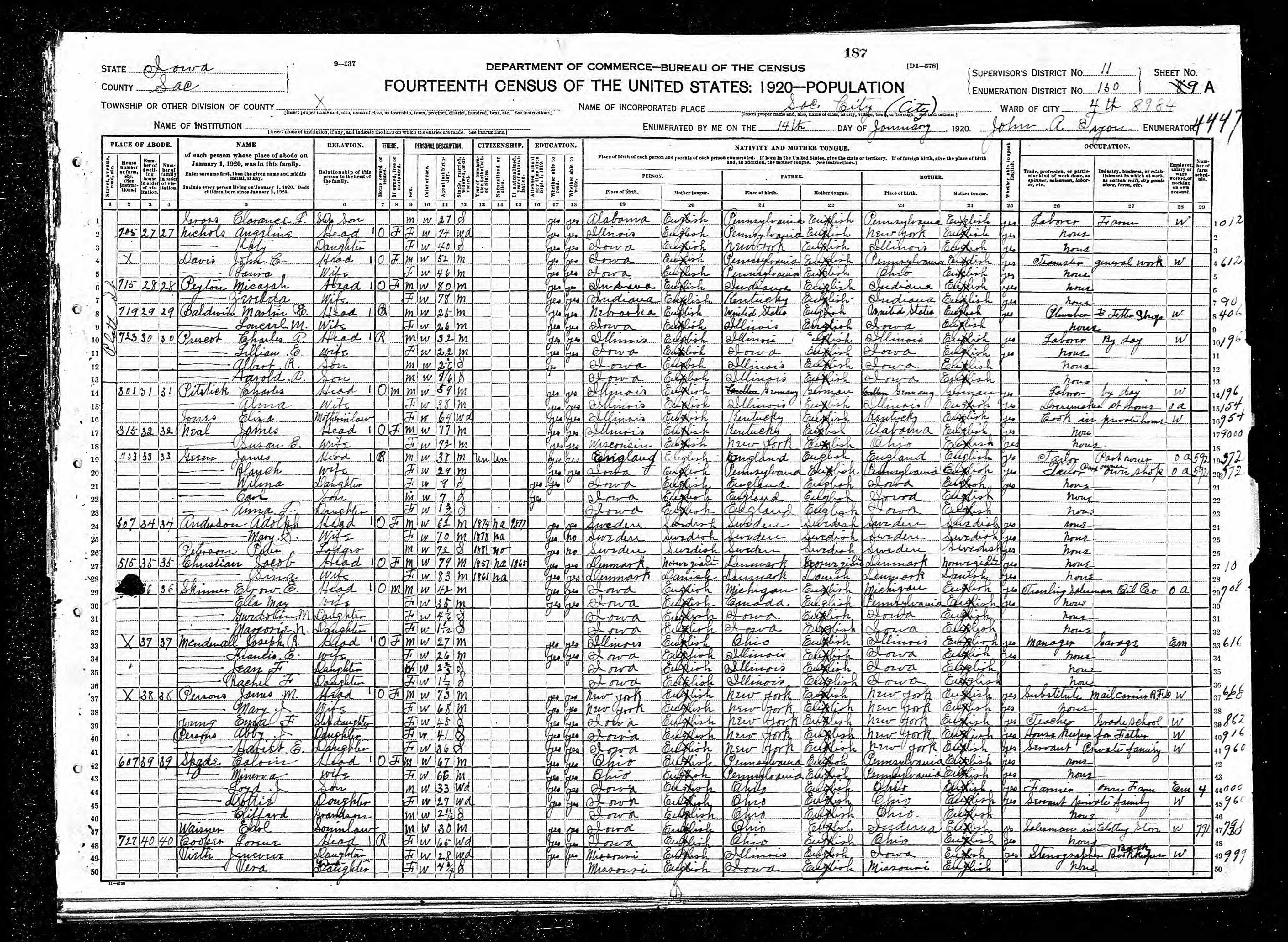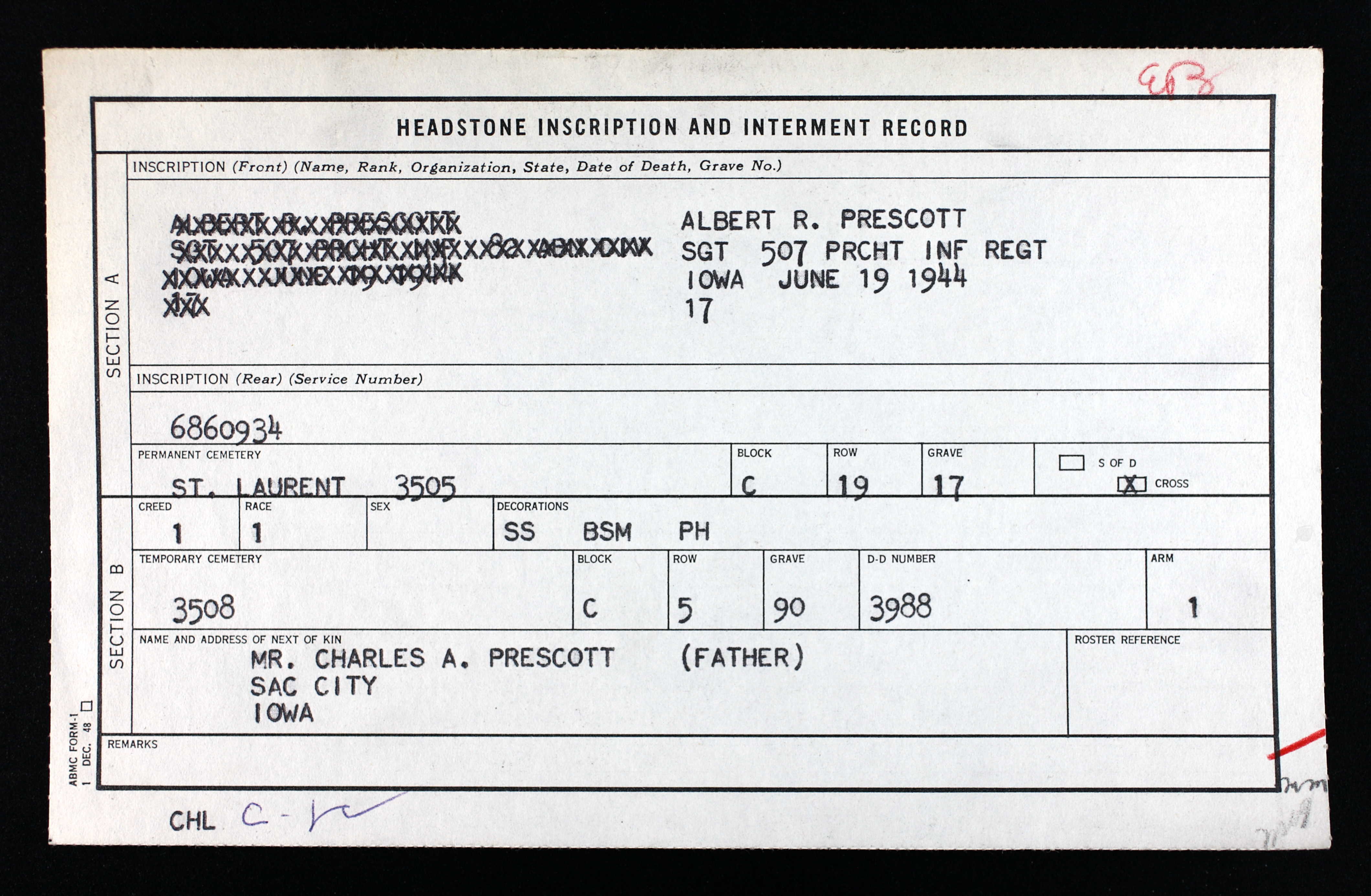Sergeant Albert Raymond Prescott

- Unit: 82nd Airborne Division, 507th Parachute Infantry Regiment, 3rd Battalion
- Service Number: 6860934
- Date of Birth: November 8, 1917
- Entered the Military: April 29, 1942
- Date of Death: June 19, 1944
- Hometown: Sac City, Iowa
- Place of Death: Normandy, France
- Award(s): Silver Star, Bronze Star, Purple Heart
- Cemetery: Plot C, Row 19, Grave 17. Normandy American Cemetery, Colleville-sur-Mer, France
Mentored by Mr. Eduardo Diaz
Perry High School
2013-2014
Early Life
Albert Raymond Prescott was born in 1918 in Sac City, Iowa. He was the oldest child of Charles and Lillian Prescott. His mother died when Albert was five years old. He had two brothers, Harold and James, and a sister, Pauline. In 1920, he levied with his parents and brother in Sac City, Iowa. His father was a day laborer. In 1930, he lived with his aunt and uncle, Louis and Julia Boyce, and their sons, Wayne and Gladwyn, on a farm in Newell Township, Iowa.
Albert married Dorothy Wagner of Hinsdale, Illinois, and together they had a child.



Homefront
Located in the heart of Iowa, Sac City grew crops to keep the American war effort moving and feed starving civilians throughout the formerly Axis-occupied countries in Europe and Asia. Iowa farmers abided by the slogan “Food will win the war” and worked diligently to supply as much food as they could. According to The Sac Sun, Sac City’s citizens also assisted the war effort by collecting scrap metal drives, planting victory gardens, holding knitting bees, and fundraising money for war bonds.
The newspaper affirms that the residents of the town endured strict rationing. Despite that, there were countless instances of individuals donating their rations to others in need. Motion pictures featured prominently in The Sac Sun. Each week, there was an advertisement for a different film—most of the images related to the war and were intensely patriotic. The newspaper had the grim responsibility to honor the local boys that passed away during World War II.
An hour away from Sac City, the town of Algona, Iowa, was home to a Prisoner of War camp. Camp Algona housed nearly 10,000 Prisoners of War. The German prisoners toiled as farmhands in local fields of soldiers fighting overseas. Sac City demonstrated the quintessential rural Iowa town during World War II, filled with hard-working folks who pull together in every way to help America win the war.
Military Experience
On April 29, 1942, Prescott enlisted in East St. Louis, Illinois. Records indicated that he might have had prior experience with the National Guard. His brother, Harold, enlisted after him. He volunteered to be a paratrooper with the “Down to Earth Boys,” The 82nd Airborne Division, 507th Parachute Infantry Regiment. Albert trained to become a paratrooper at Fort Benning, Georgia.
The 507th Parachute Infantry Regiment transferred locations to Great Britain and was stationed in Northern Ireland in the winter of 1943. In spring 1944, they moved to Nottingham, England, to prepare for the Normandy Invasion.
Paratroopers rose early on the morning of June 6, 1944, and jumped in the dark. They would have heard the roaring of anti-air guns, the howl of the thousands of airplanes, and the whoosh of air, as they plummeted to the ground.
The 507th Parachute Infantry Regiment’s objective was to capture the crucial port of Cherbourg. Prescott battled along with his regiment until D-day plus 8. He assembled a machine gun at a strategic crossroads under heavy enemy artillery fire and small arms. He courageously stayed at his position and continued firing the machine gun until the Germans retreated. His actions caused the deaths of three German soldiers while allowing his platoon to advance.
Later that day, he left his secure position and was fatally wounded, carrying an injured soldier in his platoon. He lasted five more days until finally dying of his injuries on June 19, 1944. The body of Sergeant Albert Prescott was first buried in a temporary cemetery in Blosville. He was finally laid to rest at the Normandy American Cemetery in Colleville-sur-Mer.
Sergeant Prescott was posthumously awarded the Silver Star, the Bronze Star, and the Purple Heart for his bravery and loyalty to the United States.

Eulogy
In the poem “The young dead soldiers do not speak,” the poet, Archibald Macleish, wrote, “we leave you our deaths, give them their meaning.”
Sergeant Albert Prescott was not drafted. He enlisted in the U.S. Army on April 29, 1942, in East St. Louis, Illinois. He volunteered to join the 82nd Airborne Division, 507th Parachute Infantry Regiment, known as the Down to Earth Boys.
On the morning of June 6, 1944, Sergeant Prescott jumped out of his plane and parachuted into the Norman countryside. He survived the landing. His objective was to help secure the port of Cherbourg. He fought along with his regiment until D-day plus 8. On June 14, 1944, Sergeant Prescott personally set up a machine gun at a strategic crossroads under heavy enemy small arms and artillery fire. He bravely remained at his position. He kept the machine gun firing, killing three Germans. His action forced the remaining defenders to retreat and allowed his platoon to advance.
Later on that day, he left his covered position and was fatally wounded carrying an injured brother-in-arms. His body was temporally buried in the farm field turned cemetery of Blosville. His family placed a memorial marker in Oakland Cemetery, in the farming community of Sac City, Iowa.
He was awarded a Silver Star, a Bronze Star, and a Purple Heart for his bravery. Sergeant Prescott exemplifies the idea of sacrifice for freedom because he enlisted to help liberate people he never met. All of our soldiers used to be “Silent Heroes,” but they are silent no longer because of the Normandy Institute. Their stories have been brought to light. Together we are helping our soldiers’ lives gain the meaning they deserve.
Sergeant Albert Raymond Prescott was truly a model soldier to show courage and sacrifice of the greatest generation.


Bibliography
Primary Sources
Albert R. Prescott. Iowa State Census Collection, 1836-1925. Digital images. ancestry.com.
Albert R. Prescott. Iowa World War II Bonus Case Files for Beneficiaries, 1947-1959. Digital images. ancestry.com.
Albert R. Prescott. Headstone and Interment Records for U.S. Military Cemeteries on Foreign Soil, 1942-1949. Digital images. ancestry.com.
Albert R. Prescott. World War II Army Enlistment Records, 1938-1946. ancestry.com.
Albert Ray Prescott. Iowa, Births and Christenings Index, 1800-1999. ancestry.com.
Albert Raymond Prescott. World War II Draft Cards Young Men, 1940-1947. Digital images. ancestry.com.
Iowa. Buena Vista County. 1930 U.S. Federal Census. Digital images. ancestry.com.
Iowa. Sac County. 1920 U.S. Federal Census. Digital images. ancestry.com.
Macleish, Archibald. “The young dead soldiers do not speak.” Poem. 1940. www.loc.gov/resource/rbpe.24204400/?st=text.
Secondary Sources
“Albert Prescott.” Find a Grave. Updated June 21, 2010. Accessed March 5, 2021. www.findagrave.com/memorial/53942598/albert-prescott.
“Albert R. Prescott.” American Battle Monuments Commission. Accessed March 6 , 2021. www.abmc.gov/decedent-search/prescott%3Dalbert.
“Albert R. Prescott.” The Hall of Valor Project. Accessed March 6, 2021. valor.militarytimes.com/hero/91412.
Ambrose, Stephen E. Band of Brothers E Company, 506th Regiment, 101st Airborne From Normandy to Hitler’s Eagle’s Nest. New York: Simon & Schuster, 1992.
Morgan, Martin K.A. Down to Earth: The 507th Infantry Regiment in Normandy. Atglen: Schiffler, 2004.
“Sgt Albert R. Prescott.” Find a Grave. Updated August 8, 2010. Accessed March 5, 2021. www.findagrave.com/memorial/56648945/albert-r-prescott.

